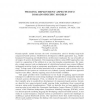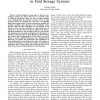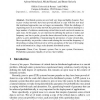TSP
2008
14 years 3 months ago
2008
Abstract--In the design of distributed quantization systems one inevitably confronts two types of constraints--those imposed by a distributed system's structure and those impo...
ACTA
2005
14 years 3 months ago
2005
Clusters and distributed systems offer fault tolerance and high performance through load sharing. When all n computers are up and running, we would like the load to be evenly distr...
SAC
2006
ACM
14 years 3 months ago
2006
ACM
The objective of testing is to determine the conformance between a system and its specification. When testing distributed systems, the existence of multiple testers brings out the...
JSS
2006
14 years 3 months ago
2006
This paper describes an approach to the feature location problem for distributed systems, that is, to the problem of locating which code components are important in providing a pa...
DC
2007
14 years 3 months ago
2007
We present a randomizedself-stabilizing leaderelection protocol and a randomizedself-stabilizing token circulation protocol under an arbitrary scheduler on anonymous and unidirect...
JCSS
2008
14 years 3 months ago
2008
With the growing number of Web applications and their variety, the need to prevent unauthorised access to data and to ensure data integrity in distributed systems has led to an in...
IJSEKE
2006
14 years 3 months ago
2006
pecific models increase the level of abstraction used to develop large-scale component-based systems. Model-driven development (MDD) approaches (e.g., ModelIntegrated Computing and...
GRID
2006
Springer
14 years 3 months ago
2006
Springer
Abstract-- Shared temporary storage space is often the constraining resource for clusters that serve as execution nodes in wide-area distributed systems. At least one large nationa...
CORR
2008
Springer
14 years 3 months ago
2008
Springer
Distributed systems are now both very large and highly dynamic. Peer to peer overlay networks have been proved efficient to cope with this new deal that traditional approaches can ...
CORR
2010
Springer
14 years 3 months ago
2010
Springer
Self-stabilization is an versatile approach to fault-tolerance since it permits a distributed system to recover from any transient fault that arbitrarily corrupts the contents of ...



